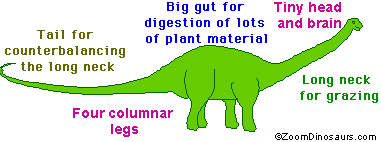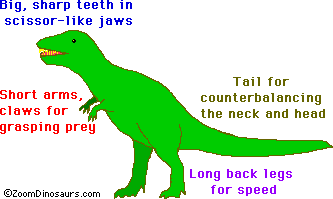Advertisement.
EnchantedLearning.com is a user-supported site.
As a bonus, site members have access to a banner-ad-free version of the site, with print-friendly pages.
Click here to learn more.
(Already a member? Click here.)
Dinosaur Anatomy and Physiology
GENERAL ANATOMY
Dinosaurs were land-dwelling reptiles that walked with an erect stance. Their unique hip structure caused their legs to stick out under their bodies, and not sprawl out from the side (as with other reptiles).
There were many different types of dinosaurs, differing in size and weight, locomotion (two- or four- legged walk, fast or slow speed), diet (meat or plants), and just about every other physiological and anatomical measure.
The following are just two of the many different types of dinosaurs.
The following drawing is of a typical large Sauropod, a four-legged, slow moving herbivore (eats plants):

The following drawing is of a typical theropod, a fast, two-legged carnivore (eats animals):

SKELETAL FEATURES
Anatomically, dinosaurs have >skeletal features that distinguish them from other archosaurs (crocodilians and pterosaurs). Dinosaurs have reduced fourth and fifth digits on their hands, their feet have three large toes, they have three or more vertebrae composing the sacrum (fused vertebrae by the hip), and have an open hip socket (a three-bone structure). This hip structure gives dinosaurs a posture that positions their legs under their bodies, unlike other reptiles, which have sprawling legs.
Dinosaurs are classified by their hip structure, into the Order Saurischia (meaning lizard-hipped) and the Order Ornithischia (meaning bird-hipped). This division by pelvic (hip) structure is based on their evolutionary tree; early in the Triassic period, dinosaurs branched into these two groups from their ancestor, the Thecodontia.
DINOSAUR LOCOMOTION
 Huge dinosaurs with short legs, like the Apatosaurus and the other Sauropods, probably moved very slowly.
Huge dinosaurs with short legs, like the Apatosaurus and the other Sauropods, probably moved very slowly.
 Massive, heavily plated, low-slung dinosaurs, like the Ankylosaurids, must have been among the slowest of the dinosaurs.
Massive, heavily plated, low-slung dinosaurs, like the Ankylosaurids, must have been among the slowest of the dinosaurs.
 The speediest dinosaurs were the bird-like, bipedal carnivores (theropods) with long, slim hind-limbs, and light bodies. These fast dinosaurs probably weren't any faster than modern-day land animals.
The speediest dinosaurs were the bird-like, bipedal carnivores (theropods) with long, slim hind-limbs, and light bodies. These fast dinosaurs probably weren't any faster than modern-day land animals.
Paleontologists can deduce approximate dinosaur speeds by using fossilized trackway and the dinosaur's skeletal structure.
- Fossilized Trackway -
 When good series of footprints are found, they show whether a dinosaur was walking, trotting, running, or wading. The distance between prints is measured together with the size of the tracks. From this, rough speeds can be calculated. Ichnotaxia (fossil footprints)
When good series of footprints are found, they show whether a dinosaur was walking, trotting, running, or wading. The distance between prints is measured together with the size of the tracks. From this, rough speeds can be calculated. Ichnotaxia (fossil footprints)  have yielded information about dinosaurs' locomotion, speed and length of stride, whether they walked on two or four legs,
have yielded information about dinosaurs' locomotion, speed and length of stride, whether they walked on two or four legs,  and how the tail is carried (no tail tracks have been found, so tails were probably held erect). Unfortunately, linking a set of tracks with a particular species of dinosaur is virtually impossible.
and how the tail is carried (no tail tracks have been found, so tails were probably held erect). Unfortunately, linking a set of tracks with a particular species of dinosaur is virtually impossible. 
- Skeletal Structure (morphology) - After dinosaur skeletons are reconstructed from fossil remains, their leg length and estimated mass can be used to calculate their approximate maximum speeds This can be done by studying living animals whose bodies move in similar ways.
DINOSAUR OFFENSE AND DEFENSE
Weapons for protection from carnivores, for killing and eating prey, or for dealing with interspecies rivalry:
- Big, sharp, pointed teeth - The largest, sharpest teeth are from carnivores, for tearing flesh from their prey.
- Clawed feet - The second digit of theropods had the large, sharp, retractible claw, and could slash its victims.
- Grasping hands with clawed fingers - good for catching and slashing prey.
- Horns - to gore enemies.
Protection from predators or rivals:
- Large thumb claw - (in some Sauropods)
- Large size - Sauropods
 were so large that only the hugest carnivores were a danger.
were so large that only the hugest carnivores were a danger.
- Thick, leathery skin - This would provide only a bit of protection.
- Armor plating (bony plates fused into the skin) -
 Ankylosaurids (like Euoplocephalus, Ankylosaurus) were plated all over the tops of their bodies. Even their eyelids had armor plating.
Ankylosaurids (like Euoplocephalus, Ankylosaurus) were plated all over the tops of their bodies. Even their eyelids had armor plating.
- Bludgeon-like tail -Ankylosaurids (like Euoplocephalus and Ankylosaurus) had bony tails that could easily have been used for defense, which would have been useful for these lumbering, plated grazers.
- Horns and Spikes - Triceratops
 and others may have used their horns for combat with rivals or predators.
and others may have used their horns for combat with rivals or predators.
- Whip-like tail - Sauropods
 could use their massive tails to whip their enemies.
could use their massive tails to whip their enemies.
- Head butting - Pachycephalosaurs
 may have engaged in head butting with rival Pachycephalosaurs.
may have engaged in head butting with rival Pachycephalosaurs.
- Speed -
 Leaving a fight can be easier and safer than fighting. The only surviving dinosaurs, the birds, evolved from the speedy, bird-like theropods.
Leaving a fight can be easier and safer than fighting. The only surviving dinosaurs, the birds, evolved from the speedy, bird-like theropods.
DINOSAUR SKIN
 Many dinosaurs had bumpy skin; this is known from fossil evidence. A bumpy T. rex skin imprint was found by a 12 year old.
Many dinosaurs had bumpy skin; this is known from fossil evidence. A bumpy T. rex skin imprint was found by a 12 year old.
Some bird-like dinosaurs had proto-feathers  .
.
The ankylosaurids had bony plates fused into their leathery skin, which was excellent protection from predators.
had bony plates fused into their leathery skin, which was excellent protection from predators.
DINOSAUR REPRODUCTION
Nothing is known about dinosaur courtship, rivalry, pairing and mating.
Many dinosaurs laid eggs  . These eggs were similar to those of reptiles, birds and primitive mammals; it contained a membrane, the amnion, that kept the embryo moist.
. These eggs were similar to those of reptiles, birds and primitive mammals; it contained a membrane, the amnion, that kept the embryo moist.
Fossils of maiasaurs  have been found alongside six-foot-wide nests filled with eggs and hatchlings. This seems to indicate that Maiasaurs cared for their young.
have been found alongside six-foot-wide nests filled with eggs and hatchlings. This seems to indicate that Maiasaurs cared for their young.
DIET
Some dinosaurs were carnivores (meat eaters) but most were herbivores (plant eaters). There are many different ways to study dinosaur diet, including:
- Fossilized feces - Coprolites help identify dinosaurs' feeding habits.
- Teeth - A dinosaur's tooth structure also tells us what type of food the dinosaur ate. Meat eaters need sharp teeth for for tearing flesh; plant eaters have teeth that would strip, and perhaps chew, foliage.
- Gastroliths - Gizzard stones (which aided digestion), have been found with some dinosaur fossils. These also yield information about dinosaur diets.
- Girth - Gut size is also an indicator of diet. Large plant eaters need a lot of calories to sustain their mass. In order to get sufficient energy from plant matter, a lot of vegetation must be digested. This requires a large digestion area.
HIGH BLOOD PRESSURE
The heads (and brains) of the long-necked dinosaurs  were held high above their hearts. In the larger sauropods, the head could be up to 26 feet (8 m) above the heart! This presents a problem in blood-flow engineering. Paleontologists use giraffes as models to estimate Brachiosaurus blood flow. Brachiosaurus' neck articulation was more vertical (giraffe-like) than a lot of other sauropods, and could feed at heights of about 30 feet.
were held high above their hearts. In the larger sauropods, the head could be up to 26 feet (8 m) above the heart! This presents a problem in blood-flow engineering. Paleontologists use giraffes as models to estimate Brachiosaurus blood flow. Brachiosaurus' neck articulation was more vertical (giraffe-like) than a lot of other sauropods, and could feed at heights of about 30 feet.
In order to pump enough oxygenated blood to the head to operate a Brachiosaurus' brain (even this tiny sauropod brain) would require:
- A large, powerful heart - A heart weighing about 880 pounds (400 kg) would be needed to pump blood up the huge blood vessels at high pressure.
- Tremendous blood pressure - It has been estimated that large sauropods needed a pumping (systolic) blood pressure of over 600 mm of Hg (Mercury). In contrast, most mammals (including people) have systolic pressure of about 100 - 150 mm of Hg. Even the giraffes only have a systolic pressure of about 300 mm of Hg.
- Huge, muscular blood vessels - Very wide arteries would be necessary to contain neck blood flow. These vessels would need many one-way valves to keep the blood from flowing back down again before reaching the top. Also, when the neck bends downwards, too much back-flow of blood to the head would necessitate one-way valves in the veins.
HOT-BLOODED OR COLD-BLOODED?
- Hot-blooded animals (homeotherms) generate heat internally and maintain a relatively constant body temperature (higher than the average temperature of the environment). Examples include the mammals (including people) and birds. A related term is endothermy, meaning that an organism generates their own heat to maintain body temperatures.
- Cold-blooded animals (poikilotherms) have a body temperature that changes with external conditions. Examples include reptiles, who need to sun themselves in the morning to warm up, and then protect themselves in the midday heat. A related term is ectothermy, meaning that an organism uses external heat sources (and heat sinks) to regulate its body temperature.
The debate about whether dinosaurs were hot- or cold-blooded is quite controversial. It used to be assumed that dinosaurs were cold-blooded like their reptile ancestors. Some paleontologists have recently argued that at least some dinosaurs were fast, active, competed against hot-blooded mammals, lived in cool areas, were related to birds, and therefore were endothermic (generating their body own heat, or hot-blooded).
Dinosaurs evolved from cold-blooded animals (the reptiles) and evolved into warm-blooded animals (the birds). All dinosaurs, however, were not the same, and perhaps their physiologies differed also. The huge dinosaurs and the tiny dinosaurs might have used different heat-regulation strategies, just as they used different strategies for other aspect of living. A good argument for this is found among modern mammals. Although warm-blooded, there are some mammals (monotremes, the egg-laying mammals like the duck-billed platypus) whose metabolisms are close to being cold-blooded.
Basically, it's difficult or perhaps impossible to answer this question with today's knowledge. There are a lot of people thinking about this, and we'll be hearing a lot more about it.
Enchanted Learning®
Over 35,000 Web Pages
Sample Pages for Prospective Subscribers, or click below
Click to read our Privacy Policy
Enchanted Learning Search
|
Search the Enchanted Learning website for:
|
Advertisement.
Advertisement.
Copyright ©1997-2018
EnchantedLearning.com ------ How to cite a web page


 Huge dinosaurs with short legs, like the Apatosaurus and the other Sauropods, probably moved very slowly.
Huge dinosaurs with short legs, like the Apatosaurus and the other Sauropods, probably moved very slowly.